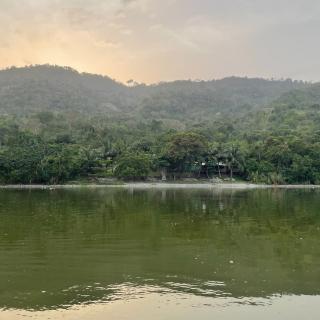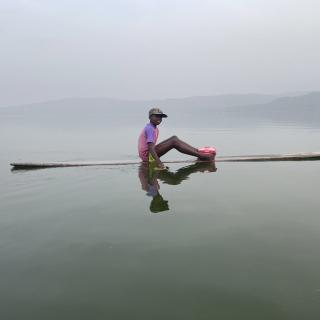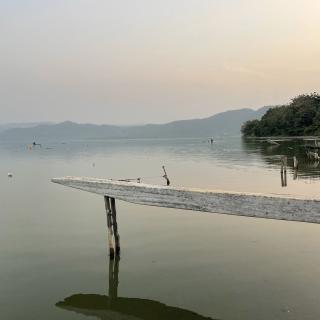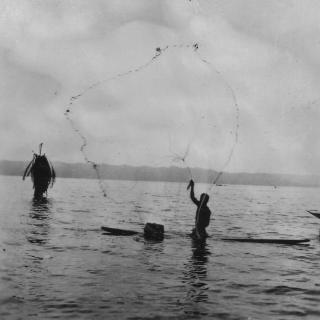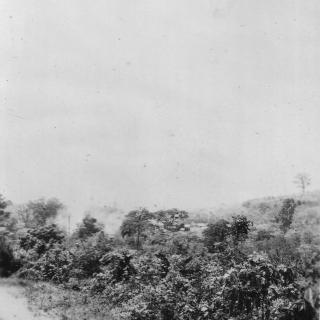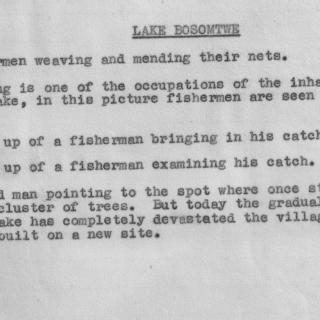11. 7. 2025–17. 8. 2025 Tjaša Rener / Returning to Bosumtwi

Tjaša Rener / Returning to Bosumtwi
UGM Kabinet, Strossmayerjeva 6
11 July–17 August 2025
opening: Friday, 11 July 2025, 19:00
curators: Patrick Nii Okanta Ankrah and Jure Kirbiš
Returning to Bosumtwi is the first solo exhibition by artist Tjaša Rener in Maribor and the first time for the Slovenian audience to experience a fragment of her ongoing Lake Side Stories project. The project can be understood as the development of a parallel artistic practice, running alongside her previously more recognized work – traditional portraiture (Portraits of Africa, Velenje Gallery, 2021), graphic still-lifes (All that Patterns, Ravnikar Gallery, Ljubljana, 2023), and spatial collages (The Place We Call Home, Tiny Gallery, 35th Ljubljana Biennale of Graphic Arts, 2023).
Returning to the shore of the crater lake Bosumtwi in Ghana is a journey through space and time for Tjaša Rener, as it is also a journey inward and across layers of meaning. With temporal and spatial distance from her formative years in Ghana, Rener has deepened and expanded her interest in the historical, social, and ecological context of this particular geographic location. If her earlier work was based on interpersonal relationships and immediate responses to new experiences, this new phase is centred around reflection – of her own position, as well as a broader connection between Lake Bosumtwi, Ghana, and the international context, with a focus on the intersections of Ghanaian and Slovenian histories and contemporary realities.
For the project, the artist invited curator and artist Patrick Nii Okanta Ankrah, with whom she has been collaborating on developing a new direction in her practice. For this exhibition, he has contributed a text offering a personal perspective on the work-in-progress. The spatial installation combines original photographs and other materials, sound recordings made by the artist at Lake Bosumtwi, and archival photographs and documents from the archives of Ghana's Ministry of Information. Through fragments of an expanded personal narrative, the exhibition invites visitors to reflect on the entanglements and interdependencies of colonial histories and contemporary social and environmental change.
“In a way, the exhibition represents the current state of my fifteen-year journey, life, and relationships with the lake and the people living along the shores of this mystical crater lake.
Lake Bosumtwi in Ghana, formed by a meteorite impact, is sacred to the Ashanti people, providing the region with sustenance, both spiritual and in terms of goods. I spent my formative years in a village by the lake, where fishermen still tell stories about the spirits of the water and about the respect and rules the lake itself demands from the people who live around it.
In recent years, I began collecting oral histories, visual archives, and writings from local residents – many of which speak about the cultural and ecological changes taking place. Accelerated environmental degradation, reduced rainfall, and increasing pollution have placed Lake Bosumtwi under significant threat, as highlighted by recent scientific appeals.
Lake Side Stories responds to this complex situation through visual storytelling. The project establishes a dialogue between myth, memory, and environmental science in the form of a poetic installation. The project is still evolving, the research continues – but a glimpse can be experienced now at the exhibition in the Maribor Art Gallery.”
—Tjaša Rener
Echoes from a Lake
“Standing on the rocky beach of Cocoa Village, which had been the artist Tjaša Rener’s homestead for twelve years, was riveting. I was beginning to understand why she had made it her home for so long. Why wouldn’t you want to be enveloped by this sublime space for the rest of your life? Her return stirred deep existential questions for the artist. How did this lake and community become catalysts for her transformation? What impacts did they have—not just on her, but on others in the community as well? What stories lie hidden here that need to be told again? And how can we, through art, reconfigure visions for the future of this place—not only as a heritage of the Asante people but as a Heritage of the World, formed a million years ago by a meteorite impact?
It was hard to gaze at the gestalt of the lake during the day, with the reflections piercing the eyes. And at night, a deep blackness abounds, save for dotted lights in the distance, hinting at sparse human settlements. The very quiet and soft plops of lake water on the shore seem like a living contradiction—a Void which speaks, to no one and to everything at the same time, resisting totalization. The plops of water intermittently interject the quietude of my raw consciousness, and thought-forms oscillate between speculative futures and imagined past possibilities.
Tjaša might have been part of the then-silent revolution taking place at the blaxTARLINES Department of Painting and Sculpture at K.N.U.S.T., spearheaded by Prof. karî'kachä seid’ou during her time at Bosomtwi. In hindsight, through some strange weaving of events, we could say that another possibility was brewing—one that culminated in our collaborations at the 35th Ljubljana Biennale of Graphic Arts, directed by our mutual friend and artist, Ibrahim Mahama [1]. It all seemed like the fulfillment of a dream shared by Josip Broz Tito, Kwame Nkrumah, and others—a dream of cross-cultural and economic pollination among nations born out of a shared struggle, which brought the vision of the Non-Aligned Movement into being. That vision, which now seems utopian, might yet be realized in other ways.
So, a return to Bosumtwi may not simply be a return with Tjaša, but a weaving of other possible stories and forgotten dreams. A return to practices, to plants, plankton, air, people, nations, insects, and myths. A return to something beyond human-centeredness—something that can speak back to the echoes of the soft plops of the waters of Lake Bosomtwi.”
— Patrick Nii Okanta Ankrah
[1] Hailing from the Department of Painting and Sculpture at Kwame Nkrumah University of Science and Technology (K.N.U.S.T.), blaxTARLINES Kumasi is an amorphous, transgenerational network of artists, curators, writers, architects, technicians, lecturers, and others. They are brought together by the Emancipatory Art Teaching Project of Prof. kąrî'kạchä seid'ou, which began in 2003. This project was designed to reorient art students toward an indifference to medium specificity, a commitment to self-curation, and a political awareness and praxis that extends beyond the contemporary art framework (seid’ou 2015).
These silent guerrilla exhibitions, which began in 2003, culminated in a series of large-scale group shows between 2015 and 2017, with additional iterations still ongoing.
In a parallel imagining, Tjaša Rener could have easily been part of this silent revolution during her stay at Lake Bosomtwi from 2013—just a 45-minute drive from the university campus.
See: Exposing Something to Someone While Exposing Someone to Something: blaxTARLINES Exhibition Cultures There-Then-And-Hereafter, African Arts 54(2): 36–51, May 2021.
Support: Municipality of Maribor, Ministry of Culture Slovenia, Pekarna Magdalenske mreže, GuestRoomMaribor
